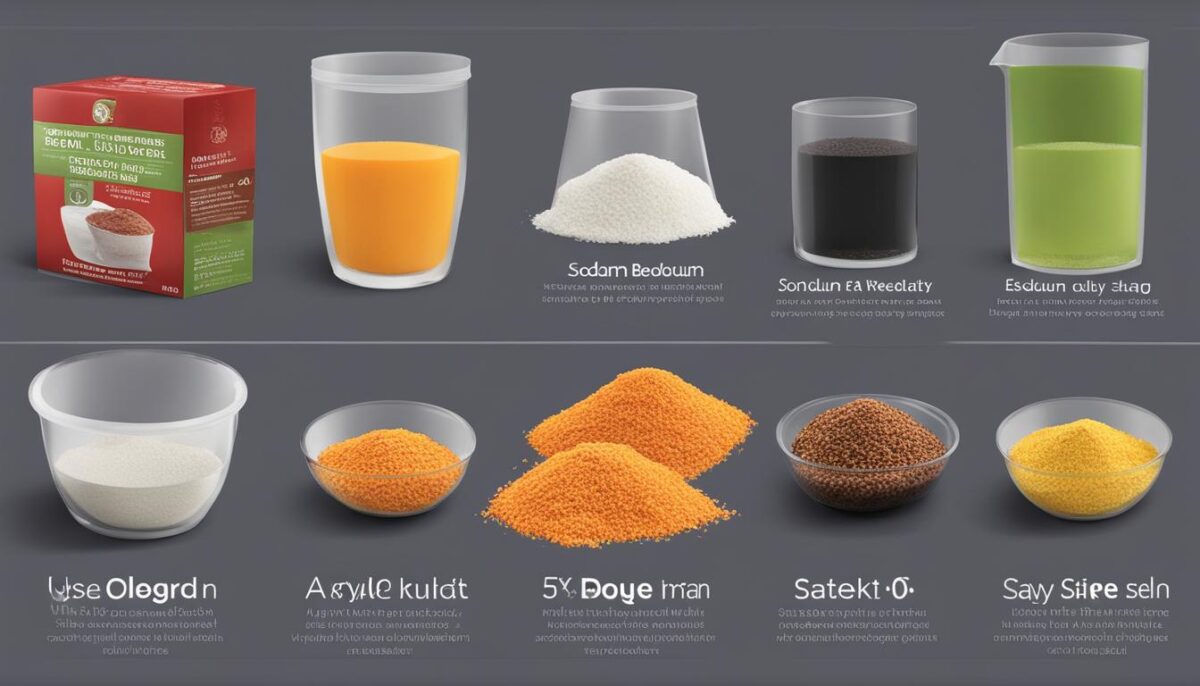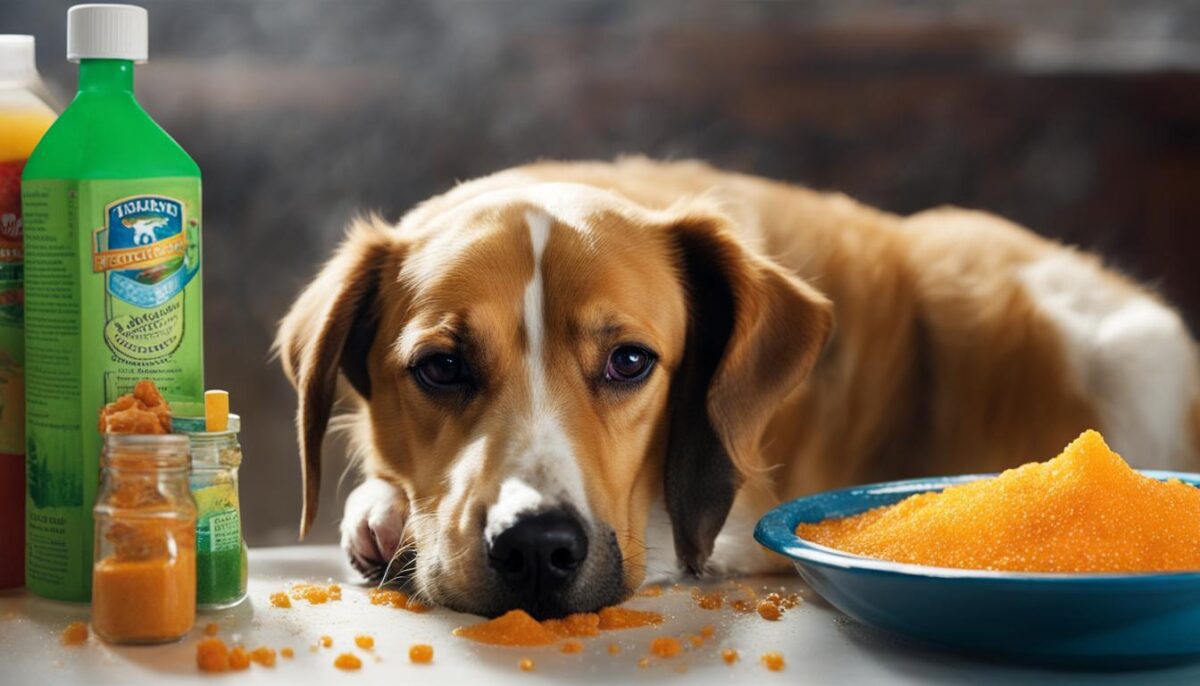Dogs need salt to stay hydrated and keep their muscles and nerves working. Excess salt can harm the brain and nerves, causing a condition called salt toxicosis. It is important to understand the proper amount of sodium that dogs can have to keep them safe and healthy.
A dog sitting next to two different bowls of food, one with high levels of sodium and the other with low levels. The dog is looking at both bowls with a curious expression.
In this article, we will talk about the risks of too much salt for dogs. We’ll also cover where dogs can get salt in their diet, how much they should have, and how to spot salt poisoning. we’ll discuss ways to prevent salt toxicity. By the end, you will understand how much sodium dogs can have and how to keep them healthy.
The Dangers of Excessive Sodium Intake for Dogs
Dogs need sodium, but too much can be harmful. Dogs can get sick if they eat too much salt, which is called salt toxicosis or salt poisoning. This can cause different health problems. In this part, we look at how too much salt can harm dogs and affect their health.
If your pet eats too much salt, they may get very thirsty, pee a lot, throw up, have diarrhea, and feel restless. If a dog’s sodium levels are imbalanced, these signs show and need immediate attention. If you have too much sodium for a long time, it can cause serious problems like kidney failure. It is important to regulate how much sodium our dogs eat for their health.
Different dog breeds and individual dogs may have different sensitivities to sodium. Certain dogs are more likely to get sick from too much salt if they have kidney or heart problems. To find the right sodium levels for your dog, consult a veterinarian for guidance.
| Dangers of Excessive Sodium Intake for Dogs | Recommended Actions |
|---|---|
| 1. Excessive thirst | Ensure access to fresh water at all times |
| 2. Increased urination | Monitor urine output and consult a veterinarian if necessary |
| 3. Vomiting and diarrhea | Seek veterinary advice if symptoms persist |
| 4. Restlessness | Provide a calm and comfortable environment for your dog |
| 5. Kidney failure | Regularly monitor kidney function and consult a veterinarian for appropriate treatment |
To keep our furry friends healthy, we should be aware of the risks of giving dogs too much salt. We can do this by giving them clean water and watching for signs of trouble. Make sure you talk to a vet about how much salt your dog should eat. It will help them stay healthy and happy.
Salt poisoning in dogs: What you need to know
When it comes to sodium levels, moderation is key for dogs. While they need some sodium for normal functions, too much can be harmful. Too much salt can make dogs sick, causing kidney failure and other health problems. Keeping an eye on sodium levels helps protect our furry friends and keep them healthy.
Sources of Sodium in a Dog’s Diet
Dogs get sodium from salty snacks, table scraps, and dog food. Dog owners should be aware of the salt in their pet’s diet and limit their food intake.
Dogs should not eat salty snacks like potato chips and pretzels because they have a lot of sodium. These snacks can lead to excessive sodium intake and increase the risk of salt poisoning.
Feeding dogs table scraps may seem harmless, but many human foods have too much sodium. Bacon, deli meat, and other savory dishes can be a significant source of sodium for dogs.
Some brands of commercial dog food may also have high sodium content. When choosing dog food, check the label for balance and nutrition that meets your pet’s needs.
| Source | Sodium Content |
|---|---|
| Salty Snacks | High |
| Table Scraps | Varies depending on the food |
| Commercial Dog Food | Can vary depending on the brand |
To reduce sodium intake in dogs, it’s important to limit salty snacks and table scraps. Instead, opt for healthy, dog-friendly treats that are low in sodium. Choosing a good dog food that meets your pet’s needs can provide proper nutrition with less salt.
Recommended Sodium Intake for Dogs
When it comes to sodium intake for dogs, it is important to find the right balance. Sodium is important for our body, but too much can cause salt toxicity and health problems. To keep your pet healthy, follow sodium guidelines and know the sodium levels in their food.
Dogs should have about 200mg of sodium if they weigh around 33lbs. But, there are no set largest limits for how much sodium dogs can have. To find the right amount of salt for your dog, talk to a vet about their size and health.
One way to regulate sodium intake is by checking the sodium percentage on dog food labels. When you’re choosing dog food, look for sodium content on the label to make informed choices. To make sure your dog gets the right amount of sodium, pay attention to their diet. This will prevent them from having too much of this important electrolyte.
The Importance of Monitoring Sodium Intake
Monitoring sodium intake is crucial for your dog’s overall health. If you eat too much salt, you may feel very thirsty and need to pee more often. It can also harm your kidneys. To keep your furry friend healthy, follow the guidelines for sodium intake and talk to a vet. This will prevent salt poisoning and other health issues.
| Sodium Intake Guidelines for Dogs | Sodium Levels in Dog Food |
|---|---|
| Consult with a veterinarian to determine appropriate sodium levels based on your dog’s size and health conditions. | Check the sodium percentage on dog food labels to regulate sodium intake. |
| Avoid excessive sodium intake to prevent salt toxicosis and health complications. | Be mindful of the sodium levels in your dog’s diet to maintain their overall health. |
To help your dog live a long, healthy life, watch their salt intake and choose their food. Make sure to talk to a vet for advice that is specific to your dog’s needs. Always put your dog’s health first.
Recognizing the Signs of Salt Poisoning in Dogs
Salt poisoning, also known as salt toxicosis, can have serious consequences for dogs. Dog owners should be able to identify signs of salt poisoning to get prompt veterinary care. The symptoms of salt poisoning may vary depending on the amount of salt ingested and the size of the dog.
One of the common symptoms of salt poisoning in dogs is excessive thirst. If your dog is always thirsty and can’t drink enough water, it might mean they have salt poisoning. Increased urination is another symptom to watch out for. If your dog is peeing more often and in bigger amounts than normal, it might mean they have salt poisoning.
Dogs with salt poisoning may have more than thirst and frequent peeing. They might also vomit, have diarrhea, have seizures, or feel restless. If your dog exhibits any of these signs, it is crucial to seek veterinary care immediately. Prompt treatment can help prevent further complications and save your dog’s life.
Signs of Salt Poisoning in Dogs:
-
Excessive thirst
-
Increased urination
-
Vomiting
-
Diarrhea
-
Seizures
-
Restlessness
It’s important to recognize and treat salt poisoning in dogs as soon as possible. Be vigilant and check your dog’s behavior and symptoms. You can protect your pet by knowing the signs of salt poisoning and acting.
Table: Symptoms of Salt Poisoning in Dogs
| Symptoms | Description |
|---|---|
| Excessive thirst | Constantly drinking water |
| Increased urination | Urinating more frequently and in larger amounts than usual |
| Vomiting | Expelling the contents of the stomach forcefully |
| Diarrhea | Loose or watery stools |
| Seizures | Uncontrolled, involuntary movements or convulsions |
| Restlessness | Unable to stay still or calm |
Preventing Salt Toxicosis in Dogs
To keep dogs safe, take a proactive approach to prevent salt toxicosis. Here are some important measures you can take:
-
Puppy-proof your home: Make your home safe for your puppy, like you would childproof for a child. To keep children safe, make sure dangerous things are not accessible. This includes items with too much salt, like snacks and cleaning products.
-
Ensure fresh water availability: Dogs should always have access to clean, fresh water. This is particularly important when it comes to managing their sodium intake. Drinking enough water helps remove extra salt from the body and keeps them healthy.
-
Avoid feeding salty foods: Especially for those with health issues. Avoid feeding your dog items like potato chips, pretzels, and other high-sodium treats.
To lower your dog’s risk of salt toxicosis, follow these preventive measures. But remember, each dog is unique, so consult a vet to meet their specific needs.
The Importance of Consulting a Veterinarian
To know how much sodium is right for your dog, consult a veterinarian who can provide guidelines. A dog’s sodium requirements can be affected by its weight, age, breed, and health.
A vet can give you advice about your dog’s diet and salt intake. They can help you make good choices. To keep your dog healthy, make sure to visit the vet and communicate with them.
Conclusion
Monitoring sodium intake is crucial for maintaining your dog’s overall health. Dogs need sodium for their bodies to work. But too much can be bad. Dog owners should be careful about the amount of salt in their pet’s food. They should talk to a vet and watch out for signs of salt poisoning.
You can keep your dog healthy by checking its sodium levels and avoiding too much sodium. To make sure your dog stays healthy, check how much sodium is in their food. Be careful not to give them salty foods or treats. It is important to consult with a veterinarian. Based on your dog’s size and health conditions, they can determine the right sodium levels.
Your dog’s health relies on a balanced and suitable amount of sodium. By being proactive in managing their sodium levels, you can help them lead a long and healthy life. Make sure you know what’s going on and pay attention to your dog’s health when it comes to salt.
FAQ
How much sodium can dogs have?
Dogs should have about 200mg of sodium if they weigh 33lbs. But, consult a vet to find the right amount of sodium for your dog’s size and health.
What are the dangers of excessive sodium intake for dogs?
Consuming too much sodium, called salt toxicosis, can cause symptoms like extreme thirst and urination. It can also raise blood pressure and lead to kidney failure.
What are the sources of sodium in a dog’s diet?
Dogs get sodium from different sources like salty snacks, table scraps, and dog food. Foods like potato chips, bacon, and deli meat can contain high levels of sodium.
What is the recommended sodium intake for dogs?
Dogs should have about 200mg of sodium if they weigh 33lbs. But, there are no established largest limits for sodium intake in dogs.
How can I recognize the signs of salt poisoning in dogs?
Dogs with salt poisoning might be very thirsty, pee a lot, throw up, have diarrhea, shake, and feel anxious.
How can I prevent salt toxicosis in dogs?
To prevent salt poisoning in puppies, make sure your home is safe from harmful substances. Always provide fresh water, and avoid giving dogs too much salty food.
Why is monitoring sodium intake crucial for maintaining a dog’s overall health?
Dogs need sodium, but too much can be bad for them. To help their dogs stay healthy, pet parents should make sure they eat the right amount of sodium.


